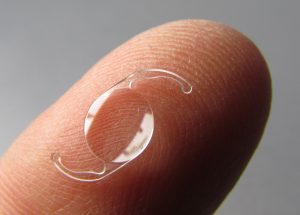A cataract is a condition of the human lens inside the eye that causes blurred vision. While cataracts occur as a natural part of the aging process, other conditions such as diabetes, vitamin deficiency, trauma, and inflammatory diseases may accelerate cataract growth.
Cataract surgery is a successful method of enhancing vision that may reduce or completely eliminate your need for glasses after the surgical procedure. That’s especially true if you choose the best option for cataract surgery in Austin.
On this page, we explore cataracts – from understanding their nature and symptoms to discovering the most effective treatments and beyond. Read on to learn more and equip yourself with the insights needed to make an informed decision about your eye health.
What Is a Cataract

If you’re here, chances are you or someone you care about is dealing with cataracts. It’s natural to have questions and concerns about this condition that affects millions worldwide.
Similar to a camera, the eye focuses images through a lens inside the eye. The lens is clear and flexible when we’re born, allowing crystal vision with a full range of focus. However, the lens becomes inflexible and cloudy as we age, causing our vision to blur and increasing our dependence on glasses.
A cloudy lens is called a cataract, and because of it, images may become blurry with age. But it’s not just about seeing less clearly; it can make it more challenging to enjoy life’s simplest pleasures, like reading, driving, watching TV, or even recognizing familiar faces. Nevertheless, cataract formation is an unavoidable part of the aging process.
What Are the Symptoms of a Cataract?
If you’re 50 or older, you might be developing cataracts as a natural part of the aging process. Although rare, some individuals may develop cataracts as children and young adults.
Common symptoms of cataracts are described below:
- Blurry vision
- Inability to see the TV clearly
- Difficulty seeing while driving at night
- Difficulty discerning fine details or reading
- Foggy, cloudy, fuzzy, filmy vision
- Glare around lights at night
- Difficulty seeing colors clearly
- Loss of vision in low-contrast situations
- Light sensitivity (to bright lights)
- Double vision
An eye examination by an ophthalmologist is necessary to determine if you have a cataract and whether it is visually significant. That said, you may not need surgery if the cataract is mild – often, an updated pair of glasses or contact lens prescription will help improve your vision. But if your vision remains cloudy despite wearing prescribed glasses, you should consider cataract surgery.
If you choose to have this procedure to improve your vision, you’ll have a choice of what type of cataract surgery you want to receive. Your decision will determine how well you can see without glasses after cataract surgery or how much you’ll have to depend on them.
When Should You Have Cataract Surgery?
How do you know if you’re a candidate for surgery? In general, you should have cataract surgery when your vision is so blurry that it hinders your ability to perform your daily activities. Often, ophthalmologists will give a prescription for glasses to improve vision before suggesting going under the knife.
However, since it is an elective surgery after all, the exact timing of cataract surgery depends solely on your choice to proceed with the procedure. Cataracts aren’t life-threatening, meaning you can wait as long as you’re satisfied with your vision. However, your vision will remain somewhat blurred, and it will worsen as time passes if you don’t opt for cataract surgery.
Patients who opt for cataract surgery do so because they can’t tolerate the blur cataracts create or desire to enhance overall vision and reduce or eliminate their dependence on glasses or contact lenses. Ultimately, the ability to see “younger” is often a powerful incentive to choose cataract surgery with an intraocular lens implant (IOL).
What Is the Best Cataract Surgery in Austin, Texas?

Lens replacement with intraocular lens implants is currently the best treatment option for cataracts. Cataract surgery in Austin has evolved over the last decade, and treatment has become safer and more effective than ever before. Traditional cataract surgery improves vision at only one point of focus, usually at a distance.
But Full Focus® Cataract Surgery at the Texan Eye surgery facilities can correct vision for near, intermediate, and distance ranges. By using high-performance, accommodating intraocular lenses, our specialists can offer enhanced visual performance, with results surpassing those from traditional cataract surgery.
What Are Intraocular Lens Implants and How Do They Work?

Intraocular lenses are clear, flexible, advanced-technology lens implants that serve as a replacement for natural lenses that have been blurred by cataracts. Although it is primarily a vision correction procedure for individuals affected by cataracts, it can also fix a refractive error that may have been present before the surgery.
What You Need to Know About Cataract Surgery in Austin, Texas
Cataract is a common surgery that is performed as a convenient outpatient procedure. On the day of surgery, you’ll arrive 1-2 hours before the surgery begins. The nurse will check your blood pressure, distribute eye drops, and may start an IV. You’ll get Valium or some other relaxing medicine to remain relaxed but not unconscious.
Then, you’ll be brought to the operating suite, where a surgeon will remove the cataract and implant the new lens. During surgery, you may experience swirling lights of patterns and colors. This life-changing procedure is actually painless, and some people even report enjoying the light show.
Some patients choose to have advanced technology used in their surgery called refractive cataract surgery. Once the cataract is removed, intraoperative technology analyzes the eye. This allows the surgeon to choose the power of the lens that has to be implanted so the patient can get the most performance out of their vision after surgery.
The incisions made during eye surgery are tiny and self-sealing, and the entire procedure should take no more than a couple of hours.
Advantages of Cataract Surgery: Restoring More than Just Sight
As a common age-related condition, cataracts can significantly impact one’s quality of life. Luckily, modern advancements in surgical techniques offer remarkable opportunities for sight restoration.
Let’s shed some light on the transformative benefits this common outpatient procedure can bring to individuals grappling with this vision impairment.
- Enhanced Vision: Cataract surgery can significantly improve visual clarity, sharpness, and color perception, allowing individuals to enjoy a clearer and more vibrant world.
- Increased Independence: Reliance on glasses or contact lenses after cataract surgery is reduced due to restored vision, fostering greater independence in navigating the surroundings and daily activities such as driving and reading, which leads to an overall improvement in quality of life.
- Long-Term Results: Our cataract surgery in Austin offers lasting results, with many patients experiencing improved vision for years to come, thus minimizing the need for further interventions.
- Safety and Efficiency: Advancements in surgical techniques have made cataract surgery one of the safest and most efficient procedures in modern medicine, with minimal discomfort and faster recovery times for most patients.
- Customized Options: From intraocular lens choices to personalized surgical approaches, cataract surgery options can be tailored to meet the unique needs and preferences of each individual, ensuring optimal outcomes.
- Prevention: Addressing cataracts early through surgery can help prevent potential complications such as glaucoma, macular degeneration, and even blindness, safeguarding long-term eye health.
The Cost of Cataract Surgery in Texas
Now, let’s talk expenses. Navigating the cost of cataract surgery in Texas is a crucial aspect for individuals from this area considering the procedure. While costs can vary depending on several factors, such as the surgeon’s experience, the type of lens implanted, and the surgical facility chosen, it’s essential to understand the numbers. So, how much does cataract surgery cost without insurance in Texas?
The average cost of cataract surgery in Austin, Texas ranges from $1,500 to $5,000 per eye for those without insurance coverage. However, factors like pre-operative consultations, post-operative care, and any additional procedures may also contribute to the overall expense. It’s advisable to book an initial consultation with ophthalmologists and surgical centers for cataract surgery in Austin to obtain accurate estimates tailored to your specific needs and circumstances.
Don’t hesitate to reach out to our team of ophthalmologists at Texan Eye for a cataract consultation – we’d be happy to answer any of your questions.
Does Insurance Cover the Costs of Cataract Surgery in Austin?
Exploring potential insurance coverage or financing options can help alleviate the financial burden associated with cataract surgery, ensuring access to this life-changing procedure for those in need. You’ll be happy to know that many major insurance companies include it in their coverage if it’s considered necessary, although details can vary from one policy to another.
Things like how much you have to pay upfront, what percentage of the cost they cover, and whether you need approval beforehand can vary, so it’s good to check the specifics of your medical insurance so you know what to expect.
Does Medicare Cover Cataract Surgery in Texas?
Yes, both Original Medicare and Medicare Advantage cover cataract surgery in Texas. The Original Medicare plan covers 80% of the cost of traditional or laser cataract surgery. The remaining 20% is the patient’s responsibility, which can be paid out of pocket or through supplemental insurance (commonly known as Medigap) if you have such a plan.
Many Medicare Advantage plans cover the full cost of cataract surgery. However, it’s essential to verify that your insurance will be accepted by the physicians, hospitals, and surgery centers before scheduling the procedure. While almost every physician and hospital is contracted with Original Medicare, the same may not be true for all Medicare Advantage plans.
At Texan Eye, we want to ensure that financial concerns don’t stand in the way of your vision. That’s why we accept a wide range of health insurance plans. Whether you’re covered by Medicare, managed care, or private insurance, chances are good that it will help cover the cost of the services you need.
Recovery From Cataract Surgery
Recovery from cataract surgery is quick – patients typically achieve significantly better vision within the first day after the procedure. Mild inflammation or corneal swelling is normal, and it may result in a hazy vision for the first couple of days following the surgery.
The vision may fluctuate slightly for the first few weeks as the eye heals, after which it stabilizes, allowing patients to go back to their normal activities.
Post-Operational Instructions
Patients typically use medicated eye drops four times per day for the first week to prevent infections and inflammation and then slowly reduce them over the next few weeks. Moreover, they should refrain from straining, heavy lifting, swimming, and eye rubbing for 14 days following the surgery.
Risks of Cataract Surgery
Although cataract surgery is one of the safest and most successful surgeries, it comes with risks like any other surgical procedure. The most common risks involved are swelling and inflammation. But these typically clear up within the first few days of recovery and with the use of medicated eye drops.
These issues rarely persist, but when they do, they can make vision cloudy for an extended period and require other medications. In severe cases, corneal edema may require additional surgery to improve the vision.
Other rare issues that may occur due to the surgery include:
Retinal Detachment
Retinal detachment occurs in less than 0.2% of patients. Very nearsighted people and those who have had complex cataract surgery are at higher risk of developing this condition. Your surgeon will review your potential risk of retinal detachment before the procedure, so it wouldn’t affect your vision after cataract surgery.
Symptoms of retinal detachment may include seeing flashing lights, a curtain blocking the vision, or a shower of floaters. If any of these symptoms occur, contact your surgeon as soon as possible.
Retinal Swelling
Retinal swelling is another rare side effect of cataract procedures that can postpone vision improvement. It’s more common in patients with an inflammatory eye disease, diabetes, or a history of retinal issues. If retinal swelling occurs, extended use of eye drops or additional procedures may be necessary to help your eyes recover.
Lens Dislocation
Lens dislocation is a very uncommon complication of cataract surgery that involves moving the lens implant from its intended place. It can happen in eyes with weak zonules (the fibers that hold the lens capsule). Weak zonules may be caused by a history of eye trauma, genetic disposition, or complex cataract surgery. If significant, it can reduce the vision and require additional surgery.
Eyes on Excellence: Opt for the Best Cataract Surgery in Austin, Texas
If you’re over 50 and notice any of the symptoms described above, it may be time to pay a visit to a doctor and improve your vision through cataract surgery. However, not all surgeons are created equal, and entrusting your eyes to someone inexperienced can pose unnecessary risks. To be on the safe side, do your research and choose experienced experts for cataract surgery in Austin, Texas, for peace of mind.
Texan Eye, our Central Austin-based cataract surgery center, has a team of 25 optometrists and ophthalmologists. Many of our surgical experts are recognized internationally as leaders in cataract and refractive surgery, while all of our physicians have received advanced training to ensure you’re in the safest hands.
When it comes to your vision, why settle for anything less than the trusted choice of fellow doctors? Choose Texan Eye for your cataract surgery in Austin. After all, eyes are the windows to the soul. Let’s keep them crystal clear – book an appointment today.
FAQ
Anything else on your mind? We’ve answered some of the most common questions about our cataract surgery in Austin to ease any worries you may have.
Is Cataract Surgery Safe?
More than 2 million people have cataract surgery every year, and it is performed without complications in over 95% of cases. That makes cataract surgery one of the safest and most successful medical procedures in the U.S.
What I See What is Happening During the Surgery?
During the surgery, you won’t see anything in the room. However, you may see swirling lights of various colors and patterns.
Is Cataract Surgery Painful?
No. The surgery is painless, thanks to the eye drops and medication.
How Long Will It Take to Recover from Cataract Surgery?
Your vision will rapidly improve a day after surgery, within the first 24 hours, then slowly over the next couple of weeks. During that time, refrain from heavy lifting, swimming, eye rubbing, and straining.
Seeing is Believing: Reviews from Our Cataract Surgery Patients
Before you take the leap, take a moment to hear from those who’ve taken it already. Behind every successful cataract surgery in Austin at our facilities is a story of hope, resilience, and transformation.
Let them inspire, reassure, and speak for themselves.
